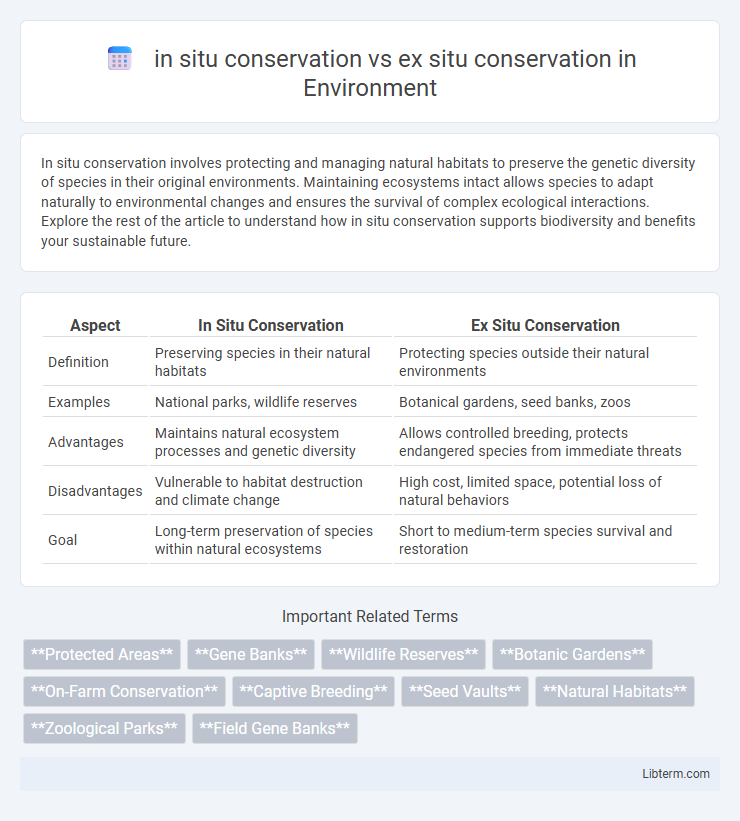In situ conservation involves protecting and managing natural habitats to preserve the genetic diversity of species in their original environments. Maintaining ecosystems intact allows species to adapt naturally to environmental changes and ensures the survival of complex ecological interactions. Explore the rest of the article to understand how in situ conservation supports biodiversity and benefits your sustainable future.
Table of Comparison
| Aspect | In Situ Conservation | Ex Situ Conservation |
|---|---|---|
| Definition | Preserving species in their natural habitats | Protecting species outside their natural environments |
| Examples | National parks, wildlife reserves | Botanical gardens, seed banks, zoos |
| Advantages | Maintains natural ecosystem processes and genetic diversity | Allows controlled breeding, protects endangered species from immediate threats |
| Disadvantages | Vulnerable to habitat destruction and climate change | High cost, limited space, potential loss of natural behaviors |
| Goal | Long-term preservation of species within natural ecosystems | Short to medium-term species survival and restoration |
Introduction to In Situ and Ex Situ Conservation
In situ conservation involves protecting species within their natural habitats, maintaining ecosystem integrity and allowing natural evolutionary processes to occur. Ex situ conservation refers to preserving genetic material or species outside their natural environments, such as in seed banks, botanical gardens, or captive breeding programs. Both strategies are essential for biodiversity preservation, complementing each other to safeguard species from extinction.
Defining In Situ Conservation
In situ conservation involves protecting species in their natural habitats, maintaining the ecological processes and genetic diversity within the original environment. This method supports the long-term survival of plants, animals, and microorganisms by preserving their natural ecosystems, such as wildlife reserves and protected forests. It contrasts with ex situ conservation, which focuses on preserving species outside their natural settings, like in seed banks or botanical gardens.
Key Features of Ex Situ Conservation
Ex situ conservation involves the preservation of species outside their natural habitats, typically in controlled environments such as botanical gardens, seed banks, and zoos. Key features include the ability to protect endangered species from immediate threats, facilitate controlled breeding programs, and maintain genetic diversity through cryopreservation and tissue culture techniques. This approach complements in situ conservation by safeguarding species that face extreme habitat loss or environmental changes.
Main Differences: In Situ vs Ex Situ Conservation
In situ conservation involves protecting species within their natural habitats, preserving the ecosystem and allowing natural evolutionary processes to continue. Ex situ conservation stores genetic material or organisms outside their natural environments, such as in seed banks, botanical gardens, or zoos, to safeguard species at risk of extinction. The main difference lies in the location and ecological context: in situ emphasizes habitat preservation, while ex situ focuses on controlled environments for species survival and genetic diversity maintenance.
Advantages of In Situ Conservation
In situ conservation preserves biodiversity within natural habitats, maintaining ecological integrity and evolutionary processes critical for long-term species survival. This method supports ecosystem services and allows species to adapt to environmental changes, enhancing genetic diversity naturally. It is cost-effective compared to ex situ conservation, which involves intensive management and infrastructure for species preservation outside their native environments.
Benefits of Ex Situ Conservation
Ex situ conservation preserves genetic diversity by maintaining species outside their natural habitats in controlled environments like seed banks, botanical gardens, and zoos. This method enables protection from habitat destruction, diseases, and climate change, ensuring survival of endangered species and facilitating research and breeding programs. Ex situ conservation supports restoration efforts by providing viable specimens for reintroduction and strengthening global biodiversity resilience.
Limitations of In Situ Approaches
In situ conservation faces limitations including vulnerability to habitat destruction, climate change, and human activities that threaten natural ecosystems. It often requires large protected areas, which can be difficult to establish and manage due to land-use conflicts and limited resources. Genetic diversity preservation is challenging when populations are small or fragmented, risking inbreeding and reduced adaptability.
Drawbacks of Ex Situ Strategies
Ex situ conservation methods, such as botanical gardens and seed banks, often face limitations including high maintenance costs and reduced genetic diversity due to small population sizes. These approaches may fail to replicate natural environmental conditions, leading to altered species behavior and adaptability. Furthermore, ex situ conservation does not support ecosystem-level interactions, which are critical for ecological balance and species survival in the wild.
Case Studies: Successful Conservation Efforts
In situ conservation exemplified by the Yellowstone National Park wolf reintroduction has restored ecosystem balance by protecting species within their natural habitats, ensuring genetic diversity and ecological processes remain intact. Ex situ conservation success is demonstrated by the Millennium Seed Bank Project, which preserves plant genetic material outside natural environments, safeguarding biodiversity against habitat loss and climate change. These case studies highlight complementary strategies crucial for global biodiversity preservation, combining habitat protection with genetic resource storage.
Choosing the Right Conservation Method
In situ conservation prioritizes protecting species within their natural habitats, ensuring the preservation of ecosystem dynamics and genetic diversity. Ex situ conservation involves safeguarding species outside their natural environments, such as in botanical gardens, seed banks, or captive breeding programs, providing controlled conditions for endangered species survival. Selecting the appropriate method depends on factors like species vulnerability, habitat stability, and resource availability, aiming to balance immediate protection with long-term ecological sustainability.
in situ conservation Infographic

 libterm.com
libterm.com